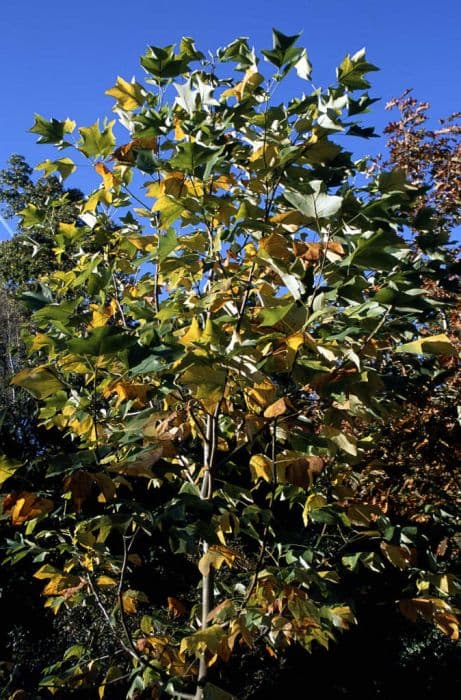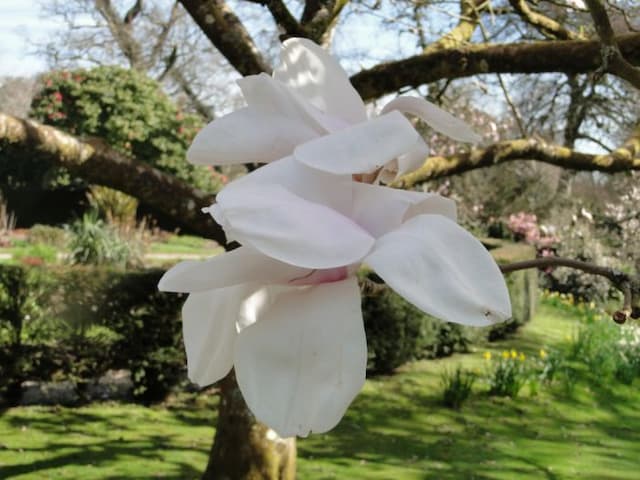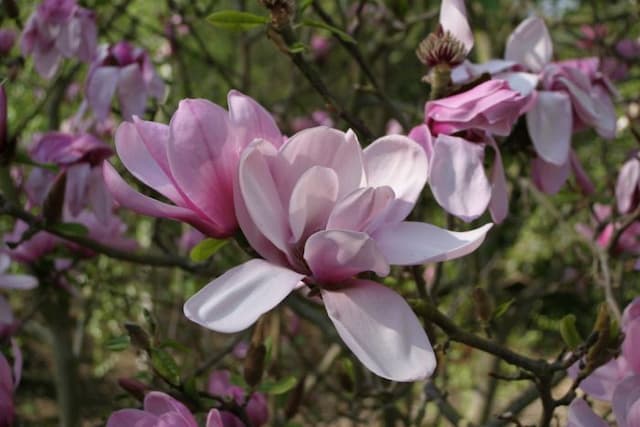Veitch's Magnolia Magnolia × veitchii 'Columbus'

ABOUT
The Magnolia × veitchii 'Columbus' is a hybrid magnolia cultivar that boasts a striking appearance when in bloom. The plant is known for its large, showy flowers which tend to be white on the inside with a blush of pink on the outer petals. These blossoms have a classic cup-and-saucer shape, creating an elegant display that is enchanting to both sight and smell, as the flowers are often fragrant. The leaves of this magnolia are dark green, glossy, and leathery, providing a handsome backdrop to its floral show. With their broad, oblong shape, they can create a lush canopy that adds texture and greenery to the garden throughout the growing season. After flowering, the plant produces attractive cone-like fruiting bodies, which add another element of visual interest to the plant. Magnolias such as the 'Columbus' are deciduous, meaning they shed their leaves annually, but before doing so, they often add a final splash of color to the landscape with leaves that turn golden brown in fall, signaling the end of the growing season. Overall, the Magnolia × veitchii 'Columbus' is revered for its stunning blooms and the luxuriousness it adds to any garden with its rich foliage and seasonal changes.
About this plant
 Names
NamesSynonyms
Veitch's Magnolia, Columbus Magnolia
Common names
Magnolia × veitchii 'Columbus'.
 Toxicity
ToxicityTo humans
The plant known as Veitch's Magnolia is generally not considered toxic to humans. There are no well-documented cases of poisoning from ingesting this plant, and it is not listed among commonly toxic garden plants. However, as with many plants, sensitivity may vary from person to person, and eating plant material could potentially cause mild stomach upset in some individuals due to the plant's natural compounds. If large amounts are ingested, or if an individual has a particular sensitivity, there could be more pronounced symptoms, such as nausea, vomiting, or diarrhea. In such cases, medical attention should be sought.
To pets
Veitch's Magnolia is not commonly known to be toxic to pets. It does not appear on lists of toxic plants for pets such as dogs and cats, and there are no widespread reports of pet poisoning from this plant. Nonetheless, it's still possible for pets to experience digestive upset if they ingest parts of this plant, especially in larger quantities. Symptoms could include vomiting, diarrhea, or drooling, as is common with the ingestion of non-food items by pets. If you suspect your pet has ingested a large amount of this plant or is showing symptoms of distress, it's advisable to contact your veterinarian.
 Characteristics
CharacteristicsLife cycle
Perennials
Foliage type
Deciduous
Color of leaves
Green
Flower color
White
Height
20-30 feet (6-9 meters)
Spread
10-15 feet (3-4.5 meters)
Plant type
Tree
Hardiness zones
6-9
Native area
Hybrid
Benefits
 General Benefits
General Benefits- Aesthetic Appeal: The plant features large, showy flowers that offer a stunning visual display, enhancing the beauty of gardens and landscapes.
- Fragrance: The flowers emit a pleasing scent that can add a delightful fragrance to the area where it is planted.
- Shade Provider: As a tree, it can provide shade once mature, making it useful for creating cooler, shaded outdoor spaces.
- Habitat for Wildlife: The Magnolia × veitchii 'Columbus' can attract pollinators such as bees and butterflies, providing a habitat and food source for them.
- Year-Round Interest: With attractive foliage, buds in winter, and flowers in the spring, it provides visual interest throughout the year.
- Cultural Significance: Magnolias are often considered symbols of grace and beauty, and can be featured in gardens for their symbolic value.
- Urban Tolerant: It is relatively tolerant to urban pollution, making it suitable for city planting.
 Medical Properties
Medical PropertiesThis plant is not used for medical purposes.
 Air-purifying Qualities
Air-purifying QualitiesThis plant is not specifically known for air purifying qualities.
 Other Uses
Other Uses- Art and Craft Inspiration: The Magnolia × veitchii 'Columbus', with its impressive blooms, can serve as a muse for artists and crafters, inspiring paintings, sculptures, and design motifs.
- Education and Research: Horticulture students and botanical researchers may study this hybrid to understand plant genetics, hybridization processes, and flowering mechanisms.
- Floral Arrangements: Its large, fragrant flowers can be used in fresh floral arrangements or centerpieces for events and special occasions due to their aesthetic appeal.
- Photography Subject: The striking beauty of the Magnolia × veitchii 'Columbus' makes it a popular subject for photographers, both amateur and professional.
- Wedding Decor: The elegant and large blooms can be used as part of wedding decor, either within the venue or as part of a bridal bouquet.
- Symbolism and Representation: The plant can symbolize nobility, purity, or perseverance and could be used in artistic or literary contexts to convey these themes.
- Perfumery: While not typically extracted for commercial fragrances, the scent of its flowers could be mimicked or used as inspiration for creating perfumes.
- Culinary Garnish: Although not commonly used in cooking, the petals could potentially be used as a decorative, non-toxic garnish for special dishes.
- Texture in Landscape Design: The thick, leathery leaves can add a contrasting texture to garden designs, particularly when paired with plants that have fine, delicate foliage.
- Cultural and Religious Ceremonies: In some cultures, the magnolia flowers may be used during certain ceremonies as a symbol of beauty and dignity.
Interesting Facts
 Feng Shui
Feng ShuiThe Magnolia is not used in Feng Shui practice.
 Zodiac Sign Compitability
Zodiac Sign CompitabilityThe Magnolia is not used in astrology practice.
 Plant Symbolism
Plant Symbolism- Purity: The magnolia flower is often associated with purity due to its pristine white petals and dignified appearance.
- Dignity: Magnolias are frequently linked to a sense of dignity, possibly because they are one of the most ancient flowers, signaling a respectful and high-standing connotation.
- Perseverance: They are early bloomers and can flower even before their leaves appear; this characteristic imbues them with the symbolic meaning of perseverance and determination to thrive.
- Beauty: Magnolias are known for their large, opulent flowers and sweet fragrance, which has made them synonymous with beauty and gracefulness.
- Nobility: The magnolia’s stature and impressive blooms also lend it an air of nobility, symbolizing one's self-respect and pride.
- Femininity: The shape and softness of the magnolia petals have contributed to its association with femininity and the gentleness often attributed to it.
 Water
WaterThe Veitch's Magnolia should be watered deeply, ensuring that the water penetrates the soil around the root zone. Water the plant with about 1 to 1.5 gallons per week, adjusting for rain and heat, to maintain moist but not soggy soil. During the growing season in spring and summer, increase the frequency to accommodate the plant's higher water needs, and reduce watering in the fall and winter when the plant is dormant. It is crucial not to let the soil dry out completely, especially in the case of newly planted trees which should be watered more regularly, about twice a week, to help establish their root systems.
 Light
LightThe Veitch's Magnolia thrives best in full sun to partial shade. The ideal location is where the plant receives at least four hours of direct sunlight per day, but is also protected from the harsh afternoon sun, especially in hotter climates. A spot that offers morning sunlight with dappled afternoon shade would be perfect to promote healthy growth and blossom development.
 Temperature
TemperatureThe Veitch's Magnolia prefers moderate temperatures and can survive minimum temperatures down to 0°F, although young plants may need protection. The ideal temperature range for optimal growth is between 60°F and 70°F. It is important to protect the magnolia from strong winds and late spring frosts which can damage the flowers and buds.
 Pruning
PruningThe Veitch's Magnolia benefits from light pruning to maintain its shape and remove any dead or damaged wood. Pruning should be done after flowering, typically in late spring or early summer, to avoid cutting off buds for the next season. Thin out any crowded branches and cut back as needed to maintain the desired form of the tree, but avoid heavy pruning as this can stress the plant.
 Cleaning
CleaningAs needed
 Soil
SoilThe Veitch's Magnolia requires a rich, well-draining soil mix comprising loam, peat, and compost with pH ranging from 5.5 to 6.5.
 Repotting
RepottingVeitch's Magnolia should be repotted every 3-5 years as it is a slowly growing plant and does not become root-bound quickly.
 Humidity & Misting
Humidity & MistingVeitch's Magnolia thrives in moderate to high humidity levels but is adaptable to lower humidity conditions if necessary.
 Suitable locations
Suitable locationsIndoor
Ensure bright light, high humidity, and cool temperatures for Veitch's Magnolia.
Outdoor
Plant in moist, well-drained soil; give partial to full sun exposure.
Hardiness zone
7-10 USDA
 Life cycle
Life cycleThe life cycle of Magnolia × veitchii 'Columbus', commonly known as Columbus magnolia, begins with seed germination, which requires stratification to break dormancy. Upon sprouting, the seedling undergoes vegetative growth, developing a robust root system and foliage to harness sunlight for photosynthesis. As it matures, the Columbus magnolia enters the flowering stage, producing its characteristic large and fragrant blooms, which are often white with hints of pink or purple. After pollination, typically by beetles attracted to the flowers, the plant forms cone-like fruit that releases seeds when mature. These seeds, once dispersed, must find suitable soil conditions to germinate, continuing the cycle. The Columbus magnolia can live for many decades, with some specimens reaching considerable size and girth, embodying their mature phase before eventually entering senescence and dying.
 Propogation
PropogationPropogation time
Spring-Early Summer
Magnolia × veitchii 'Columbus', commonly known as the Columbus magnolia, is often propagated through grafting, which is the most popular method for this plant due to its ability to maintain the characteristics of the parent plant. The best time for grafting is typically late winter to early spring, just before the new growth begins. In this process, a piece of the Columbus magnolia, called a scion, which is usually a stem with buds, is joined to a rootstock of another magnolia. The scion should be about 2-4 inches (5-10 centimeters) long. The two pieces need to be firmly bound together until the graft has taken, which involves the tissues of the scion and rootstock growing together to form a healthy, grafted plant. The success of this method heavily depends on the compatibility of the scion and the rootstock, as well as the environmental conditions surrounding the graft.









![Magnolia [Felix Jury]](/_next/image?url=https%3A%2F%2Fplants-admin.emdemapps.com%2Fimages%2Fplants%2F%2Fimages%2F604b61a0b23b7.png&w=640&q=75)